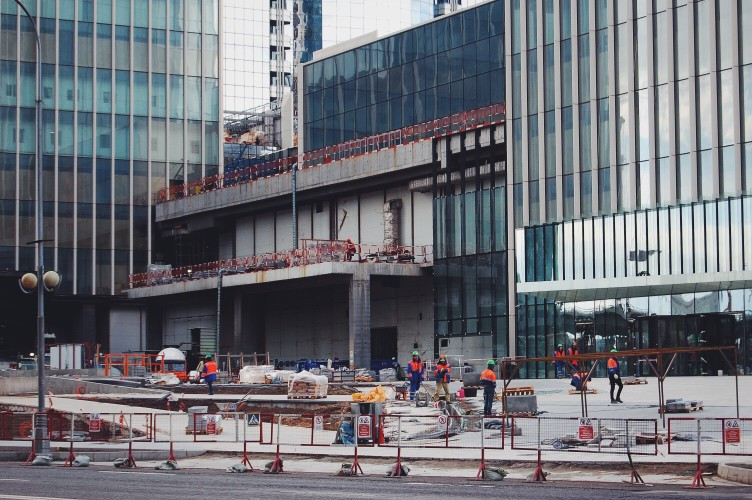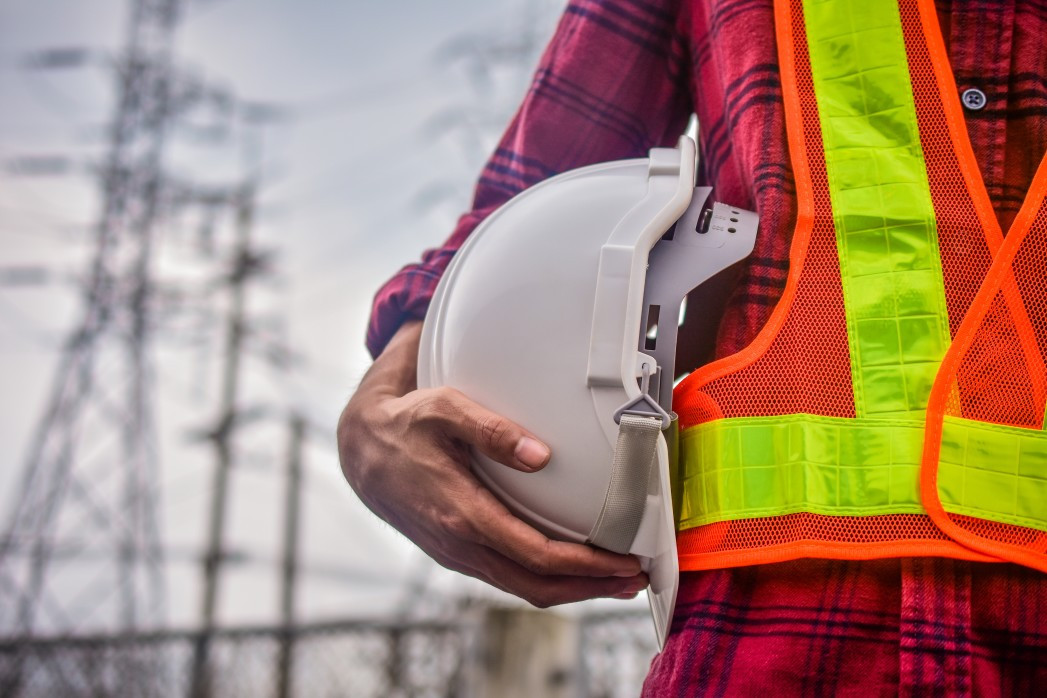How to Market Your Job Site
Proper planning and clear communication are key principles in every construction project. You wouldn’t think of starting your building without complete blueprints that every worker involved could clearly read and thoroughly understand. The same applies to your construction job site signage. You want to ensure everyone knows what your brand is and what your products are about.
There’s no better way to convey your message than with job site signs. These construction signs portray your marketing message. They state what your project offers, what it’ll look like when it’s ready and even what price range you’re selling in. Or, your "calling card" could be safety signs on your construction site. Whatever impression you’re trying to make, it’s critical you’re seen as professional and credible.

Construction Site Marketing Plans and Strategy
Job site marketing is a balance between branding the builder or developer and showing a message about the new development that’s coming soon. Branding is a long-term strategy while messaging a current construction project is more short-term. Smart construction marketers work with sign design teams to come up with clever combinations of on-site conditions and new sign materials. Solid vinyl or mesh fence wraps and project banners are popular choices.
Incorporating job site signs isn’t a new idea. Builders have always used construction signage as part of their marketing plan. However, the many benefits of using marketing materials like construction banner signs are often forgotten or at least overlooked. This oversight usually happens when you’re unfamiliar with what makes for good job site signs. That includes how to get the most from proper construction sign design, using the right materials and making strategic sign placements.
At its core, marketing your job site is all about clearly saying who you are and what you offer. It effectively promotes your overall brand and current product. Yes, it’s all advertising, but the psychology of portraying your building product has to stick and register with potential customers. Studies show that positive psychology associated with job site marketing has its best effect when customers are interested, entertained and engaged. You can easily achieve this by knowing construction site signage basics.
Construction Site Signage Basics
Job site signs should be simple. Basically, you want to have one focus, send one message and ask for one response. Keeping it simple is sage advice for all marketing plans. It’s especially applicable to construction sites where much of your audience is drive-bys. Here you have only seconds to get their attention, deliver your message and let them remember it.
According to a Microsoft study called "Attention Spans," the average person’s attention span is only eight seconds. Think about that as it applies to your job site signs. If you have only eight seconds to attract, deliver and "land" your marketing message, you need to strictly follow proven basics that work for construction site signs.
There certainly is a science behind signs. Some work remarkably well. Others are colossal failures. The difference between winning and losing jobs with signs comes down to these two principles:
- Defining Your Objective: You need to know exactly what your message is. That includes knowing what you want to achieve and knowing what you want customers to do. For construction sites, it's usually straightforward. You have a project underway and you want to attract buyers. Your signage needs to be current and reflect the stage you’re at. In the beginning, you'll be making potential customers aware of what’s coming. Midway through, you want them to know when it’s ready and to act quickly to reserve a unit. Towards the end, you want customers to know a completion date and already have a deposit in.
- Knowing Your Audience: You also need to know exactly who your audience is. Here, relevancy is the key. Your signs have to be relevant to potential buyers. With job site marketing signs, you’re in a numbers game where you’re exposing your message to hundreds or thousands of people daily. Only a small number will be potential buyers, and your message has to be relevant to them. That means you have a specific product at a certain location and within an affordable price range. With a construction sign, you want your message delivered to the maximum number of relevant people because that increases the chances of converting more of them into buyers. Ultimately, your objective is to call your audience to action.
Job Site Sign Elements
Once you’ve defined your objective, you need a combination of elements to call your relevant audience to action. Again, this comes down to signage basics. There is no substitute for clear, professional images to gain your buyers’ confidence. Here are proven elements for making excellent job site marketing signs:
- Clear Message: Your job site signs have to say who you are and what you’re selling. That means identifying your overall brand and promoting your current project. A storytelling principle dictates “less is more” — and this definitely applies to construction marketing signs. Usually, less wordiness on a sign has a bigger impact. The best way to develop your clear message is working with your marketing team and sign developer. Your message may have to go through multiple iterations before you refine it down to its most perfect form.
- Typeface: Your message wording has to be easy to read and remember. If someone passing by in those eight seconds can’t read and retain the words, your efforts may be for nothing. Proven sign typefaces are generally in the "sans-serif" family, meaning they don't have those classic curls and embellishments. Ariel and Helvetica fonts are today’s most popular typefaces. They’re easy to read and stay understated. Avoid using hard-to-read fonts like Old English. Also, avoid using all-caps and mixing fonts on one sign. This makes signs hard to read when up close, never mind when driving by.
- Images: The right images are priceless for your job site signs. They say a picture is worth a thousand words and it’s true. Images grab your audience’s attention and stay in their mind. For a construction project, the best images would be renderings of the final product or pictures of similar developments. Make sure your images are clear and, above all, colorful. They also have to be large enough to be seen from a distance. Don’t forget to use your company logo, as it’s a core part of your brand and can direct interested people to your company's other projects as well.
- Colors: Marketers know about extensive research done on color effects. There’s a reason why green refers to safety, yellow is caution and red signals danger. Those universal color codes came after significant studies on how colors affect human behavior. The same applies to highly effective marketing results using the right color combinations. The best color mixes are dark fonts on lighter backgrounds. Your most visible combinations are black, dark blue or bright red on a yellow or white base. Try to avoid white fonts on dark backgrounds with the exception of safety signs that have legally mandated color schemes.
- Clutter: Cluttered job site signs aren’t only hard to read, but they can be an actual turn off. There’s a principle in sign design called “white space”. That doesn’t refer to the amount of the color white on a sign background, although white is the most common backing used. White space means the amount of vacant area on a sign that’s not covered with typeface or images. Excessive clutter through pictures and font confuses your audience. Sign design studies show that 30 to 40% of your sign should be simple white space.
- Placement: Effective job site marketing signs have the right combination of elements, including a clear message, the right typeface, catchy images, attractive colors and uncluttered white space. They also have to be placed in the right location. Sign placement is jobsite-specific, but the one must is having your signs positioned where they’re easy to see and read. Fortunately, for most construction sites, you have excellent sign locations along your perimeter fencing, on your building face, in your windows, on your roof and even placed way up on your construction crane. The key is using existing space and turning it into high-visibility marketing signs.

Construction Signage With Fence Wraps
Your job site perimeter fence is the perfect location for marketing signs. In fact, you can make this a win-win situation by turning bare and unsightly metal fence panels into colorful signage. This is like having a running line of billboards that conventional advertisers pay dearly for.
Most temporary construction fences are rental units that have seen better days. You’re likely the same as most builders and developers who rent fence panels rather than invest in expensive products that have a temporary use. On today’s job sites, security fences aren’t optional. They’re mandated by insurance companies and by city authorities who make fencing part of permit and coverage conditions.
Covering your temporary job site fencing with marketing signs is called "wrapping." You simply wrap part of your fence or the entire run with commercially printed wrap. Your professional sign designer will take your marketing message and apply the right job site sign elements to make it the most attractive eye-catcher you can imagine. Just think of your site perimeter wrapped with your logo and message.
Construction fencing comes in two standard sizes. One panel size measures 6 feet high by 8 feet long. The other standard panel measures 6 feet high by 12 feet long. This depends on your supplier and what you specify for your site protection. The number of panels you employ depends on the protection area, which can be anywhere from a hundred feet to circling an entire block.
These panel sizes and run lengths don’t restrict your commercial fence wrap designer. Printed wraps are cut into panel-sized pieces or can have a continuous run covering your span. They’re restricted only by the length of material in a supplier’s spool, but can be seamlessly joined without notice.
Smaller and shorter flexible signs are usually called "banners." You can use banners as fence wraps as well, but they are normally site-specific and hung high up to attract attention. Banners are best for short and direct messages while wraps carry a more general theme.
Here are a few tips about fence wraps and site banners:
- Proper Size: It’s tempting to cover your entire construction fence with a marketing wrap. That would mask the stained and rusted metal associated with most panels. Unfortunately, you have wind conditions and gravity to contend with. Most fence wrap designers recommend using printed wraps made slightly smaller than full panel size. That allows better fastening that avoids saggy wraps. Gaps in fence wraps also allow better air movement and less air drag or wind shear. Banners get subjected to wind, as well. Builders often attach solid banners directly to building faces to protect them from being torn off by high winds.
- Proper Attachment: Wraps and banners need physical attachment to their support frames. Most commercial banners and wraps have metal grommets or eyelets sewn into the fabric. Make sure yours have sturdy, reinforced hems and grommet stitching. This prevents rips and tears from connection strain. There are several different types of banner connectors. Your sign designer will know what type is best.
- Proper Material: Your fence wrap and banner materials need to be strong and durable. They also have to fit within your marketing budget. Additionally, your material must be able to take printed images and typefaces that stay legible for the project’s duration. You have two common wrap and banner material options: solid vinyl and perforated mesh. Both materials have their unique benefits — choosing the proper material depends on your particular purpose and application.
Site Signs for Builders: Vinyl vs. Mesh
There is no right or wrong answer to whether solid vinyl or perforated mesh is a better fence wrap or banner material. It depends on where you’ll place the flexible sign material, how much you need, the degree of visibility you want and what your marketing budget is.
Both solid vinyl and perforated mesh banners come from material rolls. Once your sign maker works out your design, the banner or fence wrap gets digitally printed by a large-format, color inkjet. Only your message and the designer’s creativity limit the printed product.
Vinyl is generally used in small signs like banners. Depending on your situation, you may prefer it over perforated mesh materials. Here are some vinyl factors worth knowing:
- Cost-effective material
- Solid and takes fine-grained images well
- Comes in different weights and thicknesses
- Can be printed on both sides
- Tough and resists tears
While vinyl is more suitable to climate-controlled conditions, mesh banners and fence wraps are excellent choices for open areas. This is especially so for long fence wrap runs where the entire line can turn into a wind sail. These are a few benefits of using mesh signage materials:
- Mesh holes or perforations have ratios of solid to open space
- Stands up well in windy conditions
- Allows some light penetration

Construction Site Signs and Safety
Job site marketing isn’t the only reason builders and developers use signs. Safety signage for construction sites isn’t only good practice, either — regulatory agencies like OSHA make safety banners for construction sites mandatory.
Construction professionals don’t preach safety, they practice it. You’ll see safety messages everywhere on properly run construction sites, and it’s for good reason. A safe workforce is a more productive workforce. That doesn’t just mean a more profitable project. It means the site is run by caring owners who want the best and safest conditions for their workers.
Effective signs are part of every safety program. Some job site safety signs have certain requirements prescribed by OSHA and local building authorities. This includes exact color schemes to alert workers to dangerous and hazardous conditions. These signs usually follow the distinctive red and white or black and yellow pattern that immediately associate workers with caution.
Safety signage won’t dress up a job site the way marketing materials do. However, you can make safety signs look attractive as well as functional. The same design principles apply in creating meaningful safety signs. So do the same materials, and you’ll often see safety slogans and information printed on both vinyl and mesh.
City Ordinances, Codes and Job Site Signs
Something to keep in mind when working with your professional job site sign designer is legal requirements. Some civic jurisdictions have strict ordinances, codes and bylaws governing what you can erect for job site signs. Usually, that refers to sign size, height and setbacks.
You won’t likely have a problem with city enforcement objecting to on-site marketing materials such as solid vinyl banners or perforated mesh fence wrap. It’s signage presenting problems that they’re against. Examples of problem signs include massive materials that block sight lines and present traffic hazards or those that present objectionable material.
Utilizing Space With Signs on Building Sites
Creative marketers and sign designers think outside the fence when it comes to great construction signs. While a tasteful fence line and attractive marketing banner make a professional presence and excellent impression, you can go the extra mile by utilizing all your building site space. Look around and you’ll see plenty of marketing opportunities for signage.
Today’s sign technology lets you cover spaces far larger than were possible in the past. Entire building faces are prime regions for taking the same wraps from horizontal fences and placing them vertically. Both solid vinyl and perforated mesh materials work well for turning your building into a billboard.
Don’t overlook your windows as banner spots. You can cover your doors, entrances and rooftops with high-tech sign materials that are surprisingly cost-effective. Again, you’re only limited by your creativity and the artful abilities of your sign manufacturer. You might even think of decorating your construction crane.
Utilizing Cranes With Construction Site Banners
Utilizing your construction crane to hang worksite banners may be the height of creativity. It’s sure to get noticed! You can use solid vinyl for small marketing banners or perforated mesh for larger displays that are wind-exposed.
Make a statement with your construction crane signage. This is a spot where your logo really shines. Or maybe your project’s slogan. Or you might get festive. How about a red and green banner theme for the holidays or red, white and blue for the Fourth of July?
Get the Best Building and Construction Signs
You’ll get the best building construction signs when you team up with Duncan-Parnell. Since 1946, we’ve been the trusted supplier for builders, developers and construction professionals in NC, SC, GA, VA and the D.C. regions. At Duncan-Parnell, we offer professional color signage and graphic printing services that enhance your organization’s visual communications and branding.
Duncan-Parnell is your full-service sign and graphic printing solutions provider. Our talented designers provide you with everything needed to make your branding and marketing project successful. We provide front-line idea generation and product selection options as well as finishing and installation of custom graphics.
Get in touch with Duncan-Parnell today. You can reach us at 800-849-7708 or you can use our online contact form.